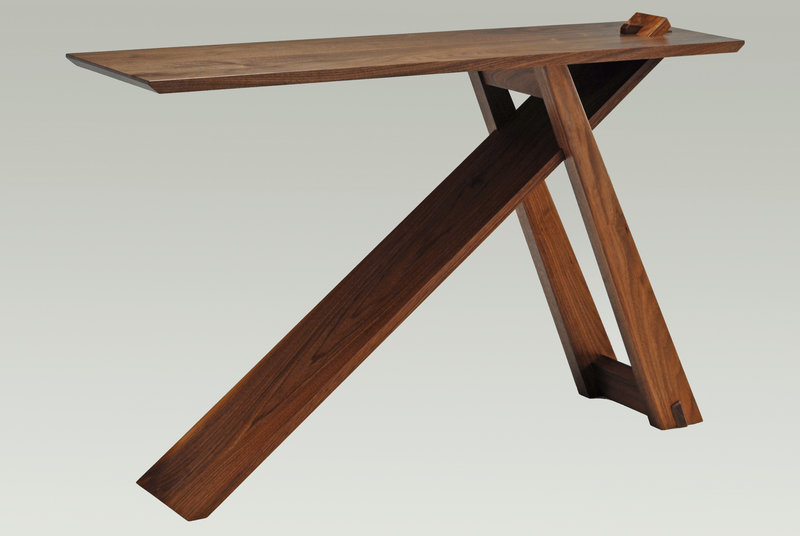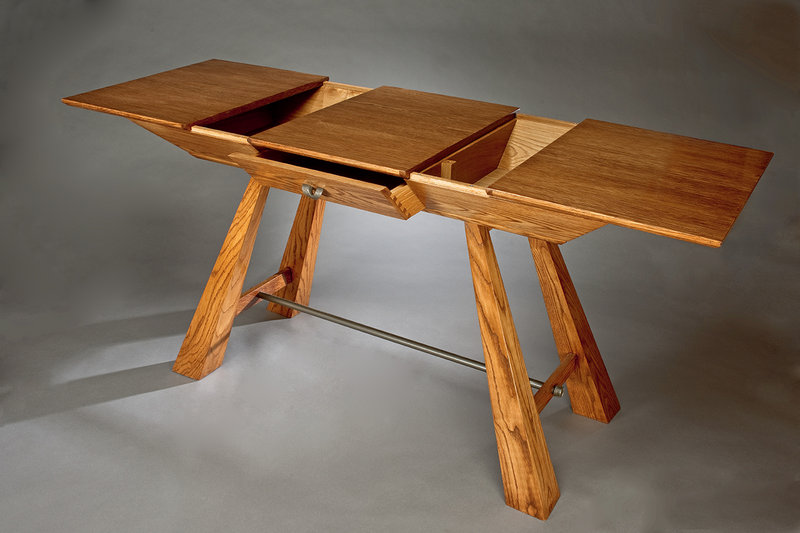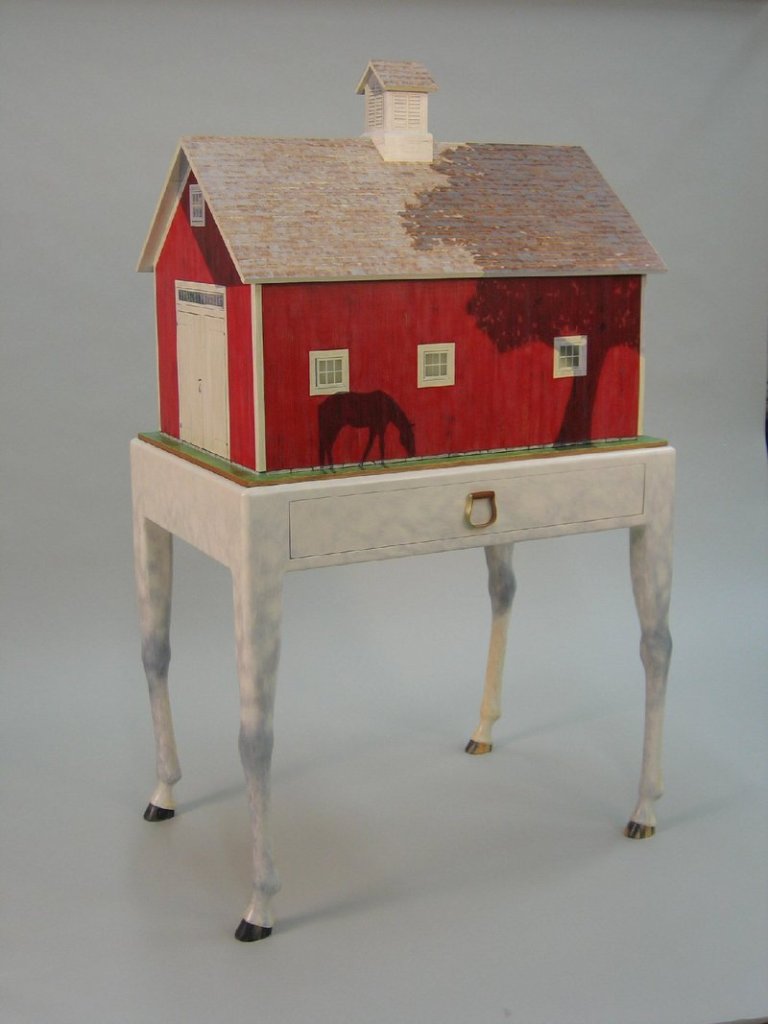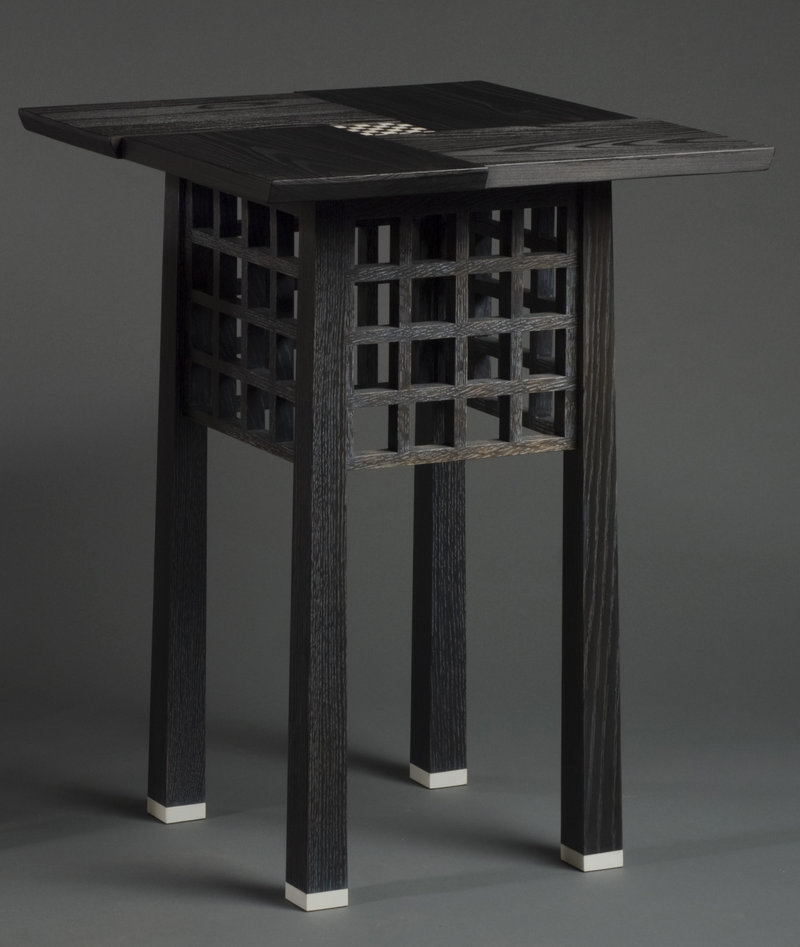One of the first things I noticed when I walked into “Maine Wood 2012” was a small sign on Gregory Crispell’s “Four Drawer Box” that reads: “Please handle with care.”
The usual operating assumption in museums and galleries, of course, is a giant, imaginary sign that says “DON’T EVEN THINK ABOUT TOUCHING THIS OR ANYTHING ELSE IN THE SHOW.” But that is not the case at the Center for Furniture Craftsmanship. Unless signage says otherwise, the public is free to handle the work. Considering how much of what they show is lusciously finished wood, it’s a wonderful difference.
Crispell’s box is a particularly good example of how and why the dynamic element of furniture can sometimes turn good design into evocatively intelligent art. This piece is an elegantly spare horizontal box of ash and maple, with four square handles symmetrically placed front and center. The piece appears to be hinged by interlocking bits of wood of the box’s sides and the outer edges of the four drawers.
This is intriguing because it hints that the drawers won’t pull straight open but, rather, butterfly outward. This makes opening them particularly satisfying. Moreover, they expand the hinges’ tiny hints of radial logic into a curvilinear interior world almost completely at odds with (yet complementary to) the linear proportions of the object’s exterior. If you could not open it, there would be no way to experience this shift.
This year’s biennial comprises 21 works selected by a jury of three: Tom Caspar, editor of American Woodworker magazine of Minnesota; Miguel Gomez-Ibanez, president of the North Bennet Street School in Boston; and Yuri Kobayashi, an instructor at the Rhode Island School of Design. While it’s not as handsome as the Center’s previous exhibition — a showcase of young American designers — it’s an entertaining and worthy show.
Like many juried shows, its flaws can mostly be chalked up to the fact that the works were juried only through photographs. Works in wood are usually meant to be seen in the round, and they rely far more than most media on textures and details, so they are particularly difficult to fully understand from just a picture or two.
One piece that brings this to mind is Gabriel Sutton’s “Liquor Cabinet.” Seeing a photo of it was one of the reasons I decided to review this instead of the center’s previous show. While it is a handsome cabinet, it is marred by the almost infuriating door hinges on its front — which are essentially invisible in the photo.
It’s not that I am some affectedly fussy detail freak, but rather it is Sutton who raises the stakes of his own details by pressing the entirety of the piece to an extremely high standard. With everything else so ably handled, it’s particularly disappointing to get caught on a problem so easily avoidable.
Not all the works, however, are about finessing intricacies. In fact, the vastness of the gamut is what makes this show so entertaining as well as an impressive testament to the range of woodwork made in Maine. Despite being only a few feet away from each other, for example, it’s quite a leap from Jon Moro’s hilariously goofy Nomar Garciaparra (who would be 9 feet tall if he stood up) to Christopher Joyce’s exquisitely tiny, lidded vessel turned from an amboyna burl.
Furniture, however, rules this year’s biennial. The juror’s award rightfully went to Kevin Rodel’s “Viennese End Table.”
Rodel takes his inspiration directly from a piece by Viennese Secession architect Josef Hoffmann, but presses it further by echoing Hoffmann’s predilection for black-and-white floor tiles with a tiny, centered grid of ebony and ivory (repurposed piano keys — which he also uses to foot the black table’s legs). Beyond its deliciously varied textures, geometrical play and elegantly sculptural presence, Rodel’s table is a wonderfully thoughtful work of reference and reverence.
My favorite works include a brilliantly simple but asymmetrical wedge table by Eban Blaney, as well as Jack Rodie’s “Trekker Work Station.” Something about Rodie’s desk really bothered me at first (why did he use a cheap steel pipe for the foot bar?), but it led me to investigate the piece more closely. After a few minutes, it became apparent that the desk could be broken down (think Ikea) and stuffed into the trunk of even the smallest car.
While the highly finished oak version doesn’t make it obvious, this is a great piece of design that could be — and should be — mass-produced.
The obvious crowd-pleaser, however, is William Doub’s luxuriously fantastical “Mystic Bed.” It’s nothing less than full-frontal Art Nouveau with an extra scoop of dreamily curvaceous indulgence.
From Tom Dahlke’s absolutely crazy and kitschy horse barn folding writing desk to Libby Schrum’s stately curvilinear bench, “Maine Wood 2012” has something for most anyone. It’s a varied and exciting show in one of Maine’s most beautiful gallery spaces.
Freelance writer Daniel Kany is an art historian who lives in Cumberland. He can be contacted at:
dankany@gmail.com
Copy the Story Link
Send questions/comments to the editors.






Success. Please wait for the page to reload. If the page does not reload within 5 seconds, please refresh the page.
Enter your email and password to access comments.
Hi, to comment on stories you must . This profile is in addition to your subscription and website login.
Already have a commenting profile? .
Invalid username/password.
Please check your email to confirm and complete your registration.
Only subscribers are eligible to post comments. Please subscribe or login first for digital access. Here’s why.
Use the form below to reset your password. When you've submitted your account email, we will send an email with a reset code.